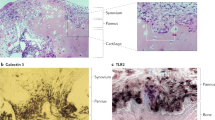Abstract
Rheumatoid arthritis is an autoimmune disease characterized by inflammation in the synovial fluid within the synovial joint connecting two contiguous bony surfaces. The inflammation diffuses into the cartilage adjacent to each of the bony surfaces, resulting in their gradual destruction. The interface between the cartilage and the synovial fluid is an evolving free boundary. In this paper we consider a two-phase free boundary problem based on a simplified model of rheumatoid arthritis. We prove global existence and uniqueness of a solution, and derive properties of the free boundary. In particular it is proved that the free boundary increases in time, and the cartilage shrinks to zero as \(t \rightarrow \infty \), even under treatment by a drug. It is also shown in the reduced one-phased problem, with cartilage alone, that a larger prescribed inflammation function leads to a faster destruction of the cartilage.

Similar content being viewed by others
References
Chen X, Friedman A (2003) A free boundary problem for an elliptic–hyperbolic system: an application to tumor growth. SIAM J Math Anal 35(4):974–986
Du Y, Guo Z (2011) Spreading-vanishing dichotomy in a diffusive logistic model with a free boundary II. J Differ Equ 250:4336–4366
Du Y, Lin Z (2010) Spreading–vanishing dichotomy in the diffusive logistic model with a free boundary. SIAM J Math Anal 42:377–405
Friedman A (2018) Mathematical biology. Modeling and analysis. In: CBMS regional conference series in mathematics, vol 127. Published for the conference board of the mathematical sciences, Washington, DC; by the American Mathematical Society, Providence
Friedman A, Hao W (2015) A mathematical model of atherosclerosis with reverse cholesterol transport and associated risk factors. Bull Math Biol 77:758–781
Friedman A, Lai X (2018) Combination therapy for cancer with oncolytic virus and checkpoint inhibitor: a mathematical model. PloS ONE 13(2):e0192449
Friedman A, Lam K-Y (2014) On the stability of steady states in a granuloma model. J Differ Equ 256:3743–3769
Friedman A, Xue C (2011) A mathematical model for chronic wounds. Math Biosci Eng 8:253–261
Friedman A, Hu B, Xue C (2010) Analysis of a mathematical model of ischemic cutaneous wounds. SIAM J Math Anal 42:2013–2040
Friedman A, Hu B, Xue C (2012) A three dimensional model of wound healing: analysis and computation. Discrete Contin Dyn Syst B 17:2691–2712
Friedman A, Hu B, Xue C (2014a) A two phase free boundary problem for a system of Stokes equations with application to biofilm growth. Arch Ration Mech Anal 211:257–300
Friedman A, Kao C-Y, Leander R (2014b) Dynamics of radially symmetric granulomas. J Math Anal Appl 412:776–791
Friedman A, Hao W, Hu B (2015) A free boundary problem for steady small plaques in the artery and their stability. J Differ Equ 259:1227–1255
Hao W, Friedman A (2014) The LDL–HDL profile determine the risk of atherosclerosis: a mathematical model. Plos ONE 9:e90497
Hao W, Schlesinger LS, Friedman A (2016) Modeling granulomas in response to infection in the lung. PloS ONE 11:e0148738
Hao W, Gong S, Wu S, Xu J, Go MR, Friedman A, Zhu D (2017) A mathematical model of aortic aneurysm formation. PloS ONE 12:e0170807
Klapper I, Dockery J (2009) Mathematical description of microbial biofilms. SIAM Rev 52:359–371
Ladyzenskaja OA, Solonnikov VA, Ural’ceva NN (1968) Linear and quasi-linear equations of parabolic type, vol 23. AMS Trans, Providence
Lai X, Friedman A (2019) Mathematical modeling in scheduling cancer treatment with combination of VEGF inhibitor and chemotherapy drugs. J Theor Biol 462:290–298
Lai X, Stiff A, Duggan M, Wesolowski R, Carson WE, Friedman A (2018) Modeling combination therapy for breast cancer with BET and immune checkpoint inhibitors. Proc Natl Acad Sci 115:5534–5539
Lieberman GM (1996) Second order parabolic differential equations. World Scientific, Singapore
Moise N, Friedman A (2019) Rheumatoid arthritis—a mathematical model. J Theor Biol 461:17–33
Pan H, Xing R, Hu B (2018) A free boundary problem with two moving boundaries modeling grain hydration. Nonlinearity 31(8):3591–3616
Siewe N, Yakubu AA, Satoskar AR, Friedman A (2017) Granuloma formation in leishmaniasis: a mathematical model. J Theor Biol 412:48–60
Wang M (2015) The diffusive logistic equation with a free boundary and sign-changing coefficient. J Differ Equ 258:1252–1266
Wang Y, Guo S (2019) A SIS reaction–diffusion model with a free boundary condition and nonhomogeneous coefficients. Discrete Contin Dyn Syst Ser B 24:1627–1652
Wang Q, Zhang T (2010) Review of mathematical models for biofilms. Solid State Commun 150:1009–1022
Weller FF (2008) Platelet deposition in non-parallel flow. Influence of shear stress and changes in surface reactivity. J Math Biol 57:333–359
Weller FF (2010) A free boundary problem modeling thrombus growth. J Math Biol 61:805–818
Xue C, Friedman A, Sen C (2009) A mathematical model of ischemic cutaneous wounds. Proc Natl Acad Sci U S A 106:16782–16787
Author information
Authors and Affiliations
Corresponding author
Additional information
Publisher's Note
Springer Nature remains neutral with regard to jurisdictional claims in published maps and institutional affiliations.
Rights and permissions
About this article
Cite this article
Friedman, A., Lam, KY. Analysis of a mathematical model of rheumatoid arthritis. J. Math. Biol. 80, 1857–1883 (2020). https://doi.org/10.1007/s00285-020-01482-1
Received:
Revised:
Published:
Issue Date:
DOI: https://doi.org/10.1007/s00285-020-01482-1




